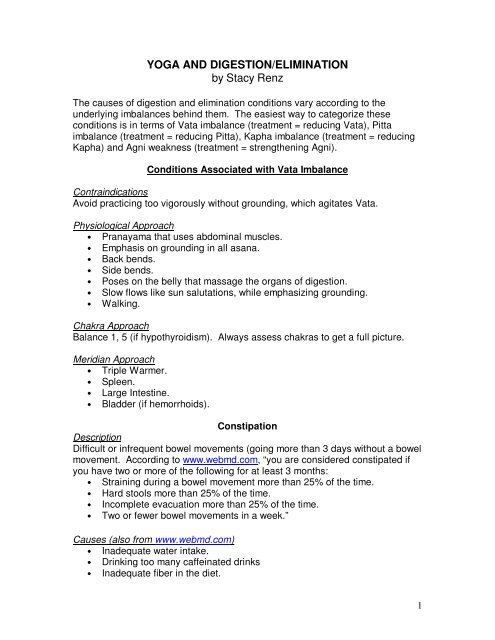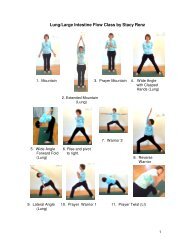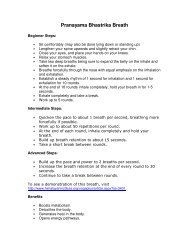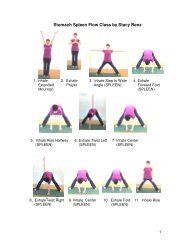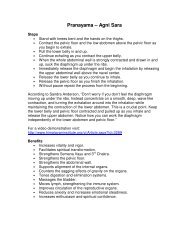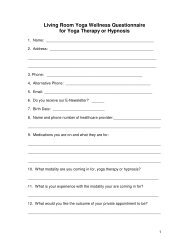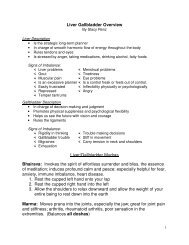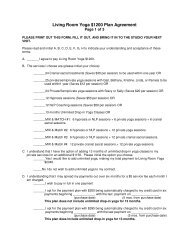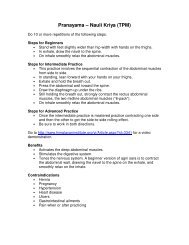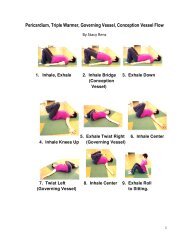YOGA AND DIGESTION/ELIMINATION by Stacy Renz - Living Room ...
YOGA AND DIGESTION/ELIMINATION by Stacy Renz - Living Room ...
YOGA AND DIGESTION/ELIMINATION by Stacy Renz - Living Room ...
- No tags were found...
Create successful ePaper yourself
Turn your PDF publications into a flip-book with our unique Google optimized e-Paper software.
have this condition. When these pouches become inflamed it is calleddiverticulitis (see below under Conditions Associated with Pitta imbalance.CausesThe theory is that the diverticulosis develops out of the straining involved inconstipation. Thus the same factors that lead to constipation can lead todiverticulosis. These include lack of exercise and a low fiber diet.SymptomsMay be asymptomatic or there may be tenderness over the affected area orabdominal cramps.Mind-Body PerspectiveAccording to Shapiro difficulties in the large intestine may have to do with“clinging to what has already served its purpose.” This may lead to prolongedgrief or sadness. She may have a fear of letting go because of a lack of trust inwhat may come next.Mind-Body ApproachFocus on themes around “releasing what no longer serves you,” recognizing theneed to let go, releasing grief and sadness, and trusting that she will always havewhat she needs. AfFORMations may includeWhy do I easily release what no longer serves me?Why is it easy for me to see when I need to let go?Why do I release my grief and sadness now?Why do I trust that I always have what I need?Ayurvedic ApproachBalance Pitta if inflammation is present in the form of diverticulitis (seeConditions Associated with Pitta Imbalance). Then balance the original Vataimbalance.Sample Class for Conditions Associated with Vata Imbalance(YTT = Yoga Teachers Toolbox and TPM = Therapeutic Pose Manual).• Pranayama – Bastrika (TPM).• Pranayama – Kapalabhati (TPM)• Pranayama - Agnisar Kriya (TPM)• Pranayama – Nadi Sodhana (TPM)• Repetitive Mulabandha (TPM)• Repetitive Uddiyana Bandha (TPM)• Mountain (YTT 13)• Vinyasa Sequence (YTT 10)• Sun Salutation (YTT 12)• Triangle (YTT 18)• Separate Leg Head to Knee (YTT19)3
• Frog (YTT 38)• Seated Spinal Twist (YTT 43)• Marichi Twist (YTT46)• Knee Down Twist (YTT47)• Cobra (YTT 41)• Locust (YTT 52)• Seated Boat (YTT 29)• Prone Boat (YTT 53)• Bow (YTT 54)• Shoulderstand (YTT 84)• Seated Forward Fold (YTT• Yoga Mudra (YTT 67)• Head to knee (YTT 68)• Reclining Bound Angle (YTT 34B)• Reclining Hero (TPM or YTT 58)• Plough (YTT 85)• Hasta Mudra 1 (pinkies touching)• Hasta Mudra 2 (ring fingers toucing)• Interlaced Mudra 1 (Interlaced pinkies)• Interlaced Midra 2 (Interlaced ring fingers)• Kanishtha Sharira Mudra (web space of hands on waist)• Adho Merudanda Mudra (fingers curled into palm, thumbs facing eachother)Conditions Associated with Pitta ImbalanceContraindicationsPoses that stimulate the bowels such as prone back bends, twists, deep forwardbends and standing postures. Most of the poses presented for constipation willbe contraindicated here. Though core strengthening is a major part of applyingyoga to these conditions, be careful not to allow the client to become overheated,which agitates Pitta.Physiological ApproachInversions and supported poses that slow down the elimination process and calmthe nervous system.Chakra ApproachBalance 1 and 3. Assess all chakras for a full picture.Meridian ApproachLarge intestine, Stomach, Spleen, Bladder, Kidney, Triple Warmer.4
“scared shitless” about something. Diarrhea prevents the absorption of nutrientsin the body – on the the level of mind it may be that the client is having difficultyabsorbing the love and nurturing that is being offered to her.Mind-Body ApproachUse themes around immunity from poisonous situations, staying present andbreathing into what is happening right now, facing with strength and courage anydifficulty she is experiencing – embracing it as teacher, acknowledgment andassimilation of feelings, readily receiving the love and nurturing that is availableto her. AfFORMations may include:Why am I able to feel truly strong in poisonous situations?Why am I able to face whatever is going on right now?Why am I able to acknowledge and assimilate my feelings?Why am I able to receive, absorb and use the love and nurturing availableto me?Sample Class DiarrheaNote that YYT = Yoga Teachers Toolbox and TPM = Therapeutic Pose Manual• Pranayama – Alternate Nostril Breathing• Pranayama – Follow the breath between the naval and the throat• Reclining Bound Angle (YTT 34B)• Reclining Hero (TPM or YTT 58)• Full Bridge (TPM)• Supine Hand to Toe (YTT 22)• Doorway Stretches (TPM)• Headstand (YTT 87)• Shoulderstand on Chairs (TPM)• Inverted Staff Pose (on chair) (TPM)• Reverse Process (YTT 86)• Supported Savasana (TPM)• Restorative Inversion (TPM)• Mudras – Interlaced Mudra 2 (ring fingers interlaced)• Mudras – Adho Merudanda (fingers curled into palm; thumbs toward eachother)DiverticulitisDescriptionSee the description of diverticulosis above. When the diverticulae becomeinflamed it is called diverticulitis.CausesSee diverticulosis above.Symptoms• Alternating diarrhea with constipation.• Painful cramps or tenderness in the lower abdomen.• Chills or fever.6
Mind-Body PerspectiveAccording to Shapiro difficulties in the large intestine may have to do with“clinging to what has already served its purpose” leading to prolonged grief orsadness. She may have a fear of letting go because of a lack of trust in whatcomes next. Inflammation is indicative of anger or an internal war going oninside.Mind-Body ApproachFocus on themes around “releasing what no longer serves you,” recognizing theneed to let go, releasing grief, sadness, and anger, trusting that she will alwayshave what she needs. AfFORMations may includeWhy do I easily release what no longer serves me?Why is it easy for me to see when I need to let go?Why do I release my grief and sadness now?Why do I trust that I always have what I need?Why am I angry?Why are the issues of my anger clear to me?Why am I able to address the issues around my anger directly?Why is it safe for me to address my anger?Why am I now able to release my anger?Celiac DiseaseDescription (www.mayoclinic.com)• A digestive condition triggered <strong>by</strong> the consumption of the protein glutenfound in bread, pasta, cookies, pizza crust and any foods containingwheat, barley or rye.• People with celiac disease who eat foods containing gluten experience animmune reaction in their small intestines, causing damage to the innersurface of the small intestine and an inability to absorb certain nutrients.• Celiac disease can cause abdominal pain and diarrhea.• Eventually, the decreased absorption of nutrients (malabsorption) thatoccurs with celiac disease can cause vitamin deficiencies that depriveyour brain, peripheral nervous system, bones, liver and other organs ofvital nourishment.CausesNo definitive cause has been identified but it appears to have a geneticcomponent. It is more common in those with• Type 1 diabetes• Autoimmune Diseases• Thyroid disease• Down syndrome• Microscopic colitis7
SymptomsNo typical signs and symptoms exist. Common complaints are• Intermittent diarrhea• Abdominal pain• BloatingSome less obvious symptoms may be• Irritability or depression• Anemia• Stomach upset• Joint pain• Muscle cramps• Skin rash• Mouth sores• Dental and bone disorders (such as osteoporosis)• Tingling in the legs and feet (neuropathy)Indications of malabsorption of nutrients that may result from celiac diseaseare:• Weight loss• Diarrhea• Abdominal cramps, gas and bloating• General weakness and fatigue• Foul-smelling or grayish stools that may be fatty or oily• Stunted growth (in children)• OsteoporosisHeart BurnDescription• A burning sensation in your chest, just behind your breastbone, that getsworse when you lie down or bend over.• Frequent heartburn that interferes with your daily routine may be asymptom of something more serious that requires help from a doctor.CausesStomach acid backing up into your esophagus due to the lower esophagealsphincter — a circular band of muscle around the bottom part of your esophagus— relaxing abnormally which allows stomach acid to flow back up into youresophagus.SymptomsA burning sensation in your chest, just behind your breastbone, that gets worsewhen you lie down or bend over.8
Mind-Body PerspectiveAccording to Shapiro, heart burn may be indicative of swallowing down bitteremotions like anger or having aggressive feelings toward someone rise up fromwithin.Mind-Body ApproachFocus on themes such as soothing, flowing, cooling, releasing anger, openingthe heart, forgiveness, acceptance. AfFORMations may include:Why do I allow myself to slow down?Why am I able to allow myself to be soothed on all levels of beng?Why am I finding it easier to flow with life?Why am I finding it easier to move toward less anger?Why is it safe to have a soft and open heart?Why am I able to accept people the way they are?Indigestion/DyspepsiaDescriptionA collection of symptoms, including belching, bloating, and nausea that causediscomfort in the upper abdomen.Causes• Overeating• Eating too quickly• Fatty or greasy foods• Spicy foods• Too much caffeine• Too much alcohol• Too much chocolate• Too many carbonated beverages• Smoking• Nervousness• Emotional trauma• Medications, including antibiotics, aspirin and nonsteroidal antiinflammatorydrugs (NSAIDs)• Stomach inflammation (gastritis)• Pancreas inflammation (pancreatitis)• Peptic ulcers• Gallstones• Stomach cancerSymptoms• Fullness after eating very little.• Fullness lasting longer than it should after a meal.• Pain in the upper abdomen between the bottom of your breastbone(sternum) and your navel.9
• Burning in the upper abdomen between the bottom of the breastbone andnavel.• Nausea.• Bloating.ContraindicationsInversions after eating (although the client shouldn’t practice yoga too soon aftereating anyway), too intense,heating, or competitive of a yoga practice or anyasana that produces symptoms of her indigestion.Mind-Body PerspectiveAccording to Shapiro, indigestion may be indicative of swallowing down bitteremotions like anger or having aggressive feelings toward someone rise up fromwithin.Mind-Body ApproachFocus on themes such as soothing, flowing, cooling, releasing anger, openingthe heart, forgiveness, acceptance. AfFORMations may include:Why do I allow myself to slow down?Why am I able to allow myself to be soothed on all levels of beng?Why am I finding it easier to flow with life?Why am I finding it easier to move toward less anger?Why is it safe to have a soft and open heart?Why am I able to accept people the way they are?Gastroesophageal Reflux Disease (GERD)DescriptionAcid reflux occurs when the valve at the entrance to your stomach fails to closeafter food passes through it. This allows acid produced <strong>by</strong> your stomach to moveup into your esophagus, causing heartburn. If it happens more than twice aweek, it is indicative of GERD.Causes (from www.webmd.com)• Hiatal Hernia (when the upper part of the stomach and the valve at theentrance move above the level of the diaphragm.• Eating large meals or lying down right or bending over after a meal• Being overweight• Snacking close to bedtime• Eating certain citrus, tomato, chocolate, mint, garlic, onions, or spicy orfatty foods• Drinking alcohol, carbonated drinks, coffee, or tea• Smoking• Being pregnant• Taking aspirin, ibuprophen, muscle relaxers, or blood pressuremedications10
Symptoms (from www.webmd.com)• Heartburn -- a burning pain or discomfort that may move from yourstomach to your abdomen or chest, or even up into your throat• Regurgitation -- a sour or bitter-tasting acid backing up into your throat ormouth• Bloating• Bloody or black stools or bloody vomiting• Burping• Dysphagia -- a narrowing of your esophagus, which creates the sensationof food being• tuck in your throat• Hiccups that don't let up• Nausea• Weight loss for no known reason• Wheezing, dry cough, hoarseness, or chronic sore throatMind-Body PerspectiveAccording to Shapiro, indigestion may be indicative of swallowing down bitteremotions like anger or having aggressive feelings toward someone rise up fromwithin.Mind-Body ApproachFocus on themes such as soothing, flowing, cooling, releasing anger, openingthe heart, forgiveness, acceptance. AfFORMations may include:Why do I allow myself to slow down?Why am I able to allow myself to be soothed on all levels of beng?Why am I finding it easier to flow with life?Why am I finding it easier to move toward less anger?Why is it safe to have a soft and open heart?Why am I able to accept people the way they are?Chronic PancreatitisDescriptionThe function of the pancreas is to secrete digestive juices that aid in digestion. Italso releases hormones to help regulate blood sugar. Normally, the digestiveenzymes secreted <strong>by</strong> the pancreas do not become active until they reach thesmall intestine. However, in pancreatitis, the enzymes begin to attach the tissuesthat produced them. This condition can be acute or chronic.Causes• Gallstones passing through the common bile duct.• Chronic heavy alcohol use.• Abdominal trauma.• Medications.• Infections.11
• Tumors.• Genetic abnormalities of the pancreas.SymptomsAcute Pancreatitis• Usually begins with gradual or sudden pain in the upper abdomenthat sometimes extends to the back.• It may start out mild and get worse after eating.• The pain may become severe and constant and last for severaldays.• Other symptoms may include swollen and tender abdomen ,nausea , vomiting, fever, and rapid pulse.Chronic Pancreatitis• May have no pain• Or may have upper abdominal pain that spreads to the back.• The pain worsens when eating or drinking and can becomeconstant and disabling.• Other symptoms may include nausea, vomiting, weight loss,diarrhea, oily stools.Mind-Body ConnectionAccording to Shapiro, trouble with the pancreas may indicate feelingoverwhelmed and having difficulty maintaining balance between work and play,giving and receiving, fear and love. Inflammation indicates anger or being firedup about something. Is difficulty finding balance making your client angry?Mind-Body ApproachFocus on themes around ebb and flow, having more than enough stamina andenergy to meet the challenges of her life, easy balance between work and play,giving and receiving, and fear and love. AfFORMation questions may include:Why am I easily able to meet the challenges of my life?Why do I easily balance work and play?Why do I enjoy an easy balance between giving and receiving?Why do I trust the ebbs and flows of life?Why do I easily release anger?Crohn’s DiseaseDescription (from www.mayoclinic.com)• An inflammatory bowel disease (IBD) that causes inflammation of thelining of the digestive tract.• It can lead to abdominal pain, severe diarrhea and even malnutrition.• The inflammation caused <strong>by</strong> Crohn's disease often spreads deep into thelayers of affected bowel tissue.12
• Like ulcerative colitis, another common IBD, Crohn's disease can be bothpainful and debilitating and sometimes may lead to life-threateningcomplications. \• While there's no known medical cure for Crohn's disease, therapies cangreatly reduce the signs and symptoms of Crohn's disease and even bringabout long-term remission. With these therapies, many people withCrohn's disease are able to function well.Causes (from www.mayoclinic.com)• Immune Response: One theory is that a virus or bacterium is responsible.“When the immune system tries to fight off the invading microorganism,the digestive tract becomes inflamed. Currently, many investigatorsbelieve that some people with the disease develop it because of anabnormal immune response to bacteria that normally live in the intestine.”• “Heredity. Mutations in a gene called NOD2 tend to occur frequently inpeople with Crohn's disease and seem to be associated with a higherlikelihood of needing surgery for the disease. Scientists continue to searchfor other genetic mutations that might play a role in Crohn's.”Risk Factors• Being white or an Ashkenazi Jew• Having a close relative with the disease• Cigarette smoking• <strong>Living</strong> in an urban, industrialized region.• Using Accutane for acne treatment.• Use use of NSAIDS, like Ibuprophen, can make it worse.Symptoms• Range from mild to severe• May develop gradually or come on suddenly.• May go into remission at times with no symptoms.During active times symptoms may include• Diarrhea.• Abdominal pain and cramping.• Blood in your stool.• Ulcers on the surface of the intestine that eventually become largeulcers that penetrate deep into — and sometimes through — theintestinal walls. Ulcers in the mouth similar to canker sores may alsodevelop.• Reduced appetite and weight loss.People with severe Crohn's disease may also experience• Fever• Fatigue• Arthritis13
• Eye inflammation• Skin disorders• Inflammation of the liver or bile ducts• Delayed growth or sexual development, in childrenMind-Body PerspectiveAccording to Shapiro difficulties in the large intestine may have to do with“clinging to what has already served its purpose.” Prolonged grief or sadnessmay be present because the client is holding on. She may have a fear of lettinggo because of a lack of trust. Ulcers appear when worry, negativity, emotions, orsituations begin to eat away at the client leaving her feeling raw and exposed.This creates a deep need to be nurtured and soothed.Mind-Body ApproachFocus on themes around “releasing what no longer serves you,” recognizing theneed to let go, releasing grief and sadness, and trusting that she will always havewhat she needs. AfFORMations may includeWhy do I easily release what no longer serves me?Why is it easy for me to see when I need to let go?Why do I release my grief and sadness now?Why do I trust that I always have what I need?Why do I choose situations and people that help me feel soothed andnurtured?Why do I deserve to be soothed and nurtured?Why do I trust that all will turn out exactly as it should?Why do I feel protected and safe?Peptic UlcersDescripton• Occurs when acid in the digestive tract eats away at the inner surface ofthe esophagus, stomach or small intestine.• The acid can create a painful open sore that may bleed.• Your digestive tract is coated with a mucous layer that normally protectsagainst acid.• If the amount of acid is increased or the amount of mucus is decreased,you could develop an ulcer.CausesUlcers occur when the mucous layer of the stomach and small intestine isdisrupted and the lining of the stomach or duodenum becomes inflamed. Thismay occur due to• H. pylori bacteria living and multiplying within the mucous layer of thestomach and small intestine.• Taking NSAIDs like ibuprophen, naproxen, and ketoproxen on an emptystomach.• Taking osteoporosis medications like actonel and Fosomax.14
• Smoking cigarettes.• Alcohol abuse.• Any of the above + uncontrolled stress.SymptomsThe most common is intermittent burning pain anywhere from the naval up toyour breastbone that is worse on an empty stomach, at night, and which isrelieved <strong>by</strong> acid buffering foods and acid-reducing medication.Less common symptoms are• Vomiting blood — which may appear red or black• Dark blood in stools or stools that are black or tarry• Nausea or vomiting• Unexplained weight loss• Appetite changesMind-Body ConnectionAccording to Shapiro, ulcers appear when worry, negativity, emotions, orsituations begin to eat away at the client leaving her feeling raw and exposed.This creates a deep need to be nurtured and soothed.Mind-Body ApproachFocus on themes around soothing, nurturing, trusting, protection. AfFORMationquestions may include:Why do I choose situations and people that help me feel soothed andnurtured?Why do I deserve to be soothed and nurtured?Why do I trust that all will turn out exactly as it should?Why do I feel protected and safe?Inflammatory Bowel Disease (IBD)/Ulcerative ColitisDescription (from www.mayoclinic.com)• An inflammatory bowel disease that causes chronic inflammation of thedigestive tract.• Usually affects only the innermost lining of your large intestine (colon) andrectum.• It occurs only through continuous stretches of your colon, unlike Crohn'sdisease, which occurs in patches anywhere in the digestive tract and oftenspreads deep into the layers of affected tissues.• Can be debilitating and sometimes can lead to life-threateningcomplications.• Has no known cure but can be managed and even brought into long-termremission.15
Causes• Exact cause is unknown• Stress exacerbates it, but does not cause it• One theory is that the digestive tract becomes inflamed <strong>by</strong> the immunesystem fighting microornanisms there.• Another thought is that it is caused when the immune system reacts evenwhen there is no pathogen present for it to fight (as in an autoimmunedisease).• Heredity may also play a role.Risk Factors• It often affects people in their 30s.• Caucasian and Jewish people are at greatest risk.• Having a family member who has it.• Use of Accutane for acne treatments.• Use of NSAIDs, like Ibuprophen.Symptoms (directly from mayoclinic.com)Symptoms may range from mild to severe to include• Rectal bleeding and pain.• An inability to move the bowels despite the urge to do so.• Bloody diarrhea.• Abdominal cramps.• Unintended weight loss.• Fatigue.• In extreme form dehydration, shock, colon rupture and toxic megacolon,which occurs when the colon becomes severely distended.The course of ulcerative colitis varies, with periods of acute illness oftenalternating with periods of remission. But over time, the severity of the diseaseusually remains the same. Most people with a milder condition, such asulcerative proctitis, won't go on to develop more-severe signs and symptoms.Mind-Body PerspectiveAccording to Shapiro difficulties in the large intestine may have to do with“clinging to what has already served its purpose” leading to prolonged grief orsadness. She may have a fear of letting go because of a lack of trust in whatcomes next. Issues pertaining to the rectum may have to do with anger, abuse,violation, or sitting on one’s feelings. Ulcers appear when worry, negativity,emotions, or situations begin to eat away at the client leaving her feeling raw andexposed. This creates a deep need to be nurtured and soothed.Mind-Body ApproachFocus on encouraging your client to release what no longer serves her,recognizie the need to let go, release grief, sadness, and worry, acknowledgeand voice her feelings, and trust that she will always have what she needs.16
AfFORMations may includeWhy do I easily release what no longer serves me?Why is it easy for me to see when I need to let go?Why do I release my grief and sadness now?Why do I trust that I always have what I need?Why do I choose situations and people that help me feel soothed andnurtured?Why do I easily acknowledge and share my feelings?Why do I deserve to be soothed and nurtured?Why do I trust that all will turn out exactly as it should?Why do I feel protected and safe?Sample Class for Conditions Associated with Pitta ImbalancePlease note that YTT indicates Yoga Teachers Toolbox and TPM TherapeuticPose Manual.During a flare-up, do the practices for either diarrhea or constipation, dependingon which symptom is dominant. Between flare-ups incorporate the following intoa balanced yoga practice.• Cat Cow – (YTT 8)• Wind-Removing Pose (Knee to Chest YTT 31)• Seated Spinal Twist (YTT 43)• Twist from Hero Pose (TPM)• Seated Forward Bend from the edge of a chair with belly supported onbolsters (YTT 69)• Head to Knee with head on bosters and hand holding sides of chair (YTT68)• Downward Facing Dog with head on block (YTT 26)• Separate Leg Forward Fold with head on block (YTT 72)• Standing Forward Bend with head on block (YTT 73)• Triangle Pose (YTT 18)• Lateral Angle (YTT 17)• Balancing Half Moon (YTT 77)• Standing Twist (TPM)• Twist Seated in a chair (TPM)• Sage Bharadvaj (YTT 44)• Marichi’s Pose (YTT 46)• Reclining Supported Bound Angle (YTT 34B)• Reclining Supported Hero (TPM or YTT 58)• Shoulder Stand off chair (TPM)• Plough with chair support (TPM)• Supported Supine Boat (TPM)• Full Bridge (TPM)• Supported Legs Up the Wall (YTT 86)• Hasta Mudra 1 (pinkies touching)• Hasta Mudra 2 (ring fingers touching)17
• Interlaced Mudra 1 (Interlaced pinkies)• Interlaced Midra 2 (Interlaced ring fingers)• Kanishtha Sharira Mudra (web space of hands on waist)• Adho Merudanda Mudra (fingers curled into palm, thumbs facing eachother)• Ganesha Mudra – Interlace all fingers in front of the chest. Extend themiddle fingers and wrap the index fingers around behind them. Place thethumbs together at the base of the middle fingers.• Pranayama - Kapalabhati Breath (TPM)• Pranayama Breath - Bhastrika Breath (TPM)• Pranayama – Surya Bhedi Breath (TPM)• Pranayama – Agni Sara (TPM)• Pranayama – Nauli Kriya (TPM)• Pranayama - Nadi Shodana• Pranayama – Ujjayi Breathing• Pranayama – Viloma Krama Breath• Supported Savasana (TPM)Conditions Associated with Kapha ImbalanceGastroparesisDescription• Delayed gastric emptying due to the stomach muscles not working tocrush and move the food into the small intestine.• This leads to food fermenting in the stomach, bacterial growth, or foodhardening into hard masses that prevent it from passing into the smallintestine.CausesThe root cause is the vagus nerve, which innervates the muscles that crush foodand move it through the stomach to the small intestine, becoming damaged andnonfunctioning. This may occur due to complications of:• Diabetes, especially Type 1• Anorexia nervosa• Prolonged post-viral syndrome (“a condition after a viral infection ofchronic muscle fatigue unrelieved <strong>by</strong> rest. Other symptoms may includevisual and hearing difficulties, low-grade fever, stiff neck, urinaryfrequency, and insomnia” - http://medicaldictionary.thefreedictionary.com/postviral+syndrome)• Small intestine or stomach surgery.• Lupus or Scleroderma (autoimmune diseases)• Neurological conditions like Parkinson’s or abdominal migraine.• Metabolic disorders like hypothyroidism.18
Symptoms• Heartburn or stomach pain• Nausea• Vomiting, especially vomiting pieces of undigested food• Feeling full after only a few bites of food• Bloating• Lack of appetite• Unintended weight loss• Unstable blood sugar levels (in people who have diabetes)ContraindicationsContraindications for gastroparesis are those associated with the root conditionresponsible for it so will be covered under each condition.Mind Body ConnectionTo Shapiro issues with the stomach may indicate a lack of knowing what is goodfor us or difficulty receiving from others or giving to ourselves. In addition wemay harbor worry in the stomach so that we have a “hard time stomaching” whatis happening to us.Mind Body ApproachUse themes around inner wisdom, attracting that which contributes her highestgood, receiving her good with ease, receiving from others with ease, giving toherself, accepting what is, surrender.Questions to have your client ask herself in AfFORMation form.Why can I trust my own inner wisdom to make the best choices formyself?Why do I attract that which is for my highest good?Why do I easily receive from others?Why do I generously give to myself?Why do I so easily accept what is?Why do I find it so easy to surrender?Physiological Approach• Pranayama that strengthens and moves the stomach muscles.• Back bendsChakra ApproachBalance 3. Assess all for the full picture.Meridian Approach• Liver, Stomach• Triple Warmer, Bladder, and Kidney (for Diabetes)• Spleen (if vomiting or indigestion)19
Sample Class for Conditions Associated with Pitta ImbalancePlease note that YTT indicates Yoga Teachers Toolbox and TPM TherapeuticPose Manual.• Basically all Poses for Kapha in the YTT done is vinyasa style andfocusing on core strengthening and upward movement of energy.• Boat to Kayak (TPM)• Hasta Mudra #2 – Tips of ring fingers touching.• Hasta Mudra #3 – Tips of middle fingers touching.• Hasta Mudra #4 – Tips of index fingers touching.• Hasta Mudra # 5 – Tips of thumbs touching.• Hasta Mudra #6 – Tips of all fingers touching.• Adhi Mudra – Curl fingers around thumbs with palms down.• Merudanda Mudra – Fingers curled into the palm with thumbs up.• Pranayama - Kapalabhati Breath (TPM)• Pranayama Breath - Bhastrika Breath (TPM)• Pranayama – Surya Bhedi Breath (TPM)• Pranayama – Agni Sara (TPM)• Pranayama – Nauli Kriya (TPM)• Pranayama - Nadi Shodana• Pranayama – Ujjayi Breathing• Pranayama – Viloma Krama Breath• Supported Savasana (TPM)Conditions Associated with Weak Agni (Digestive Fire)Irritable Bowel SyndromeDescription• A large intestine (colon) disorder that causes cramping, abdominal pain,bloating gas, diarrhea and constipation.• Causes no permanent damage to the colon.• Symptoms improve with dietary and lifestyle changes and bettermanagement of stress.• Sometimes the muscles in the intestines that contract and relax to movefood through the intestinal tract may be stronger and last longer thannormal.• This forces food through the intestines too quickly which causes gasbloating and diarrhea.• At other times the opposite occurs, and food passage slows.• This causes the stool to become hard and dry leading to constipation.• Having the condition can make it hard to socialize (especially when youdon’t know if there is a bathroom near<strong>by</strong>), can cause many missed workdays, and impact one’s sex life.20
CausesThe exact cause is unknown but abnormalities in the nervous system or colonmay play a role. Some people have triggers that increase symptoms, which mayinclude:• Gas• Pressure on the intestines• Foods like chocolate, milk alcohol, carbonated beverages, some fruits andvegetables.• Emotions• Stress• Hormonal changes around the menstrual cycles• An acute episode of infectious diarrhea.Risk factors• Being under 35 – most people who get it are young.• Being female makes one 2x more likely to get it.• Having a close family member with the condition makes one more likely toget it.Symptoms• Abdominal pain or cramping• A bloated feeling• Gas (flatulence)• Alternating bouts of constipation and diarrhea• Mucus in the stoolContraindicationsNo one is supposed to practice yoga for at least two hours after eating, but this iscrucial for the person with IBS. Physical activity too soon after eating can causediarrhea.Mind-Body ConnectionAccording to Shapiro, IBS is connected to maintaining power and boundaries andwith letting go of control. The person with IBS may experience fear, lack ofconfidence, or nervousness when confronting unknown situations or may be behaving difficulty in a relationship.Mind-Body ApproachFocus on themes around courage, confidence, empowerment, healthyboundaries, and surrender. AfFORMation questions may include:Why do I face new situations with courage and confidence?Why am I so powerful?Why am I clear about my boundaries?Why do I respect and stand up for my own boundaries?Why do I so easily surrender to what is?21
Chakra ApproachBalance 1 and 3. Assess all for the full picture.Ayurvedic ApproachUnlike some of the other conditions, irritable bowel syndrome is not tieddefinitively to one dosha imbalance. Rather it is caused <strong>by</strong> a weakenedJathara agni (digestive fire) found in the small intestine which breaks down thefood into smaller molecules to be digested easily. This weakness leads toindigestion, malabsorption, and the build up of ama (toxins). This affects all thedoshas and their role in digestion. “Aggravation of doshas leads to derangeddigestive fires.” Addressing IBS Ayurvedically then involves strengthening thedigestive fire through dietary changes, pranayama, and asana. (Fromhttp://contentdig.com/health/alternative-medicine/irritable-bowel-syndromeayurveda-treatment.html).Physiological ApproachStrengthen and tone Semana Vayu (solar plexus, 3 rd chakra) through focusedpranayama, twists, forward folds, and prone back bends. Samana Vayu unitesupward flowing energy (pranavayu) and downward-flowing energy (apanavayu)at the navel center “ to awaken and enhance the prana of transformation…Semana Vayu is a concentrating, absorbing, and consolidating force. Its mainfunction is assimilation of prana in all its forms—like a power station, samanacollects energy absorbed through breath, food, sensory perception, and mentalexperiences and processes it to empower all aspects of life. (Sandra Anderson,http://www.himalayaninstitute.org/yogaplus/article.aspx?id=3654).Chakra ApproachBalance 1 and 3. Assess all chakras for the full picture.Meridian ApproachLarge intestine, Stomach, Spleen, Bladder, Kidney, Triple Warmer.Sample Class for IBS and Increasing Agni(YTT = Yoga Teachers Toolbox; TPM = Therapeutic Pose Manual)During a flare-up, do the practices for either diarrhea or constipation, dependingon which symptom is dominant. Between flare-ups incorporate the following intoa balanced yoga practice.• Table/Cat (YTT23)• Sunbird (YTT 24)• Plank (YTT 25)• Downward Dog (YTT 26)• Chair Pose (YTT 27)• Rotated Lateral Angle (20)• Seated Boat (YTT 29)22
• Supine Plank (YTT 30)• Reclining Supported Bound Angle (YTT 34 with cross bolsters behindback)• Reclining Hero (TPM)• Seated Spinal Twist (43)• Sage Bharadvaj (YTT 44)• Marichi Twist (YTT 46)• Reclining Abdominal Twist (TPM)• Functional Abdominal Strengtheners (TPM)• Cobra (YTT 51)• Prone Boat (YTT 53)• Bow (YTT 54)• Seated Forward fold with bolster support on belly (YTT 69)• Hasta Mudra 3 (middle fingers touching)• Interlaced Mudra 3 (middle fingers interlaced)• Merudanda Mudra (fingers curled into palms and thumbs up)• Shivalingam Mudra (right fingers curled into palm sitting on top of cuppedleft hand – integrates prana, udana, and semana vayus).• Pranayama - Kapalabhati Breath (TPM)• Pranayama Breath - Bhastrika Breath (TPM)• Pranayama – Surya Bhedi Breath (TPM)• Pranayama – Agni Sara (TPM)• Pranayama – Nauli Kriya (TPM)• Pranayama - Nadi Shodana• Pranayama – Ujjayi Breathing• Pranayama – Viloma Krama Breath• Supported Savasana (TPM)ReferencesAnderson, Sandra, http://www.himalayaninstitute.org/yogaplus/article.aspx?id=3654.Anderson, Sandra, http://www.himalayaninstitute.org/yogaplus/Article.aspx?id=3289.Anderson, Sandra, http://www.himalayaninstitute.org/yogaplus/article.aspx?id=3341.Anderson, Sandra, https://www.himalayaninstitute.org/yogaplus/article.aspx?id=3655.http://contentdig.com/health/alternative-medicine/irritable-bowel-syndromeayurveda-treatment.htmlhttp://digestive.niddk.nih.gov/ddiseases/pubs/diverticulosis/http://digestive-disorders.health-cares.net/gastroparesis-causes.phpfrom http://digestive-disorders.health-cares.net/gastroparesis-causes.php23
http://familydoctor.org/online/famdocen/home/common/digestive/disorders/966.htmlhttp://manageyourheartburn.com/heartburn-yoga-acid-reflux.phphttp://www.ayurbalance.com/explore_kapha.htmhttp://www.ayurport.com/Ayurveda/ulcerativecolitis.jsphttp://www.diabetes-book.com/cms/articles/9-dr-bernstein-shares-hisinsights/242-richard-k-bernstein-md-face-facn-fccws-http://www.himalayaninstitute.org/yogaplus/article.aspx?id=3654http://www.livestrong.com/article/114218-yoga-poses-crohns-disease/http://www.mayoclinic.com/health/celiac-disease/DS00319http://www.mayoclinic.com/health/heartburn-gerd/DS00095http://www.mayoclinic.com/health/indigestion/DS01141/DSECTION=symptomshttp://www.mayoclinic.com/health/irritable-bowel-syndrome/DS00106http://www.mayoclinic.com/health/ulcerative-colitis/DS00598http://www.medicinenet.com/pancreatitis/article.htm#1whatishttp://www.suite101.com/content/yoga-asanas-for-peptic-ulcers-a256097http://www.webmd.com/digestive-disorders/digestive-diseases-diarrheahttp://www.webmd.com/heartburn-gerd/guide/what-is-acid-reflux-diseasehttp://www.yoga-for-beginners-a-practical-guide.com/yoga-for-constipation.htmlhttp://www.yogiclogic.com/yoga-cures/yoga-poses-for-digestion.phphttp://www.yogiclogic.com/yoga-cures/yoga-stomach-ulcers.php.http://www.yogawiz.com/yoga-therapy/how-yoga-understands-peptic-ulcer.htmlIyengar, B.K.S. (2001). Yoga: The Path to Holistic Health. Longdon: DorlingKindersley Limited.24
Judith, Anodea (1996), Eastern Body Western Mind: Psychology and the ChakraSystem As a Path to the Self. Celestial Arts: Berkely, CA.LePage, Joseph. (1994-2002). Integrative Yoga Therapy Professional YogaTherapist Manual.LePage, Joseph & LePage, Lilian. (2005). Yoga Teachers Toolbox. IntegrativeYoga Therapy.McCall, Timothy, MD. Yoga As Medicine: The Yogic Prescription for Health andHealing. (2007). New York: Bantam Dell.Shapiro, Debbie (1997). Your Body Speaks Your Mind: How Your Thoughts andEmotions Affect Your Health. Freedom, California: The Crossing Press.25


